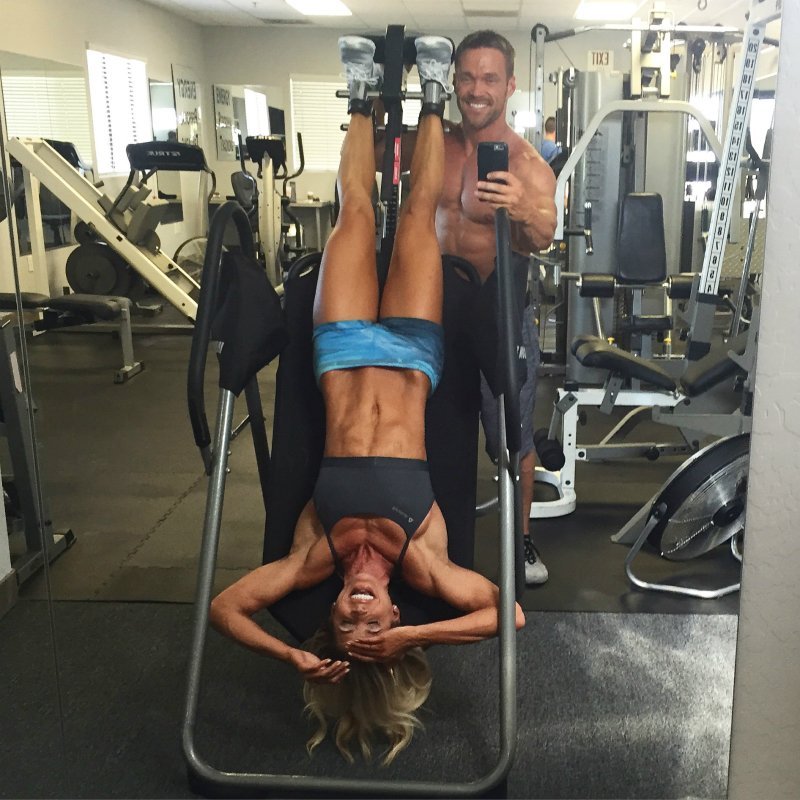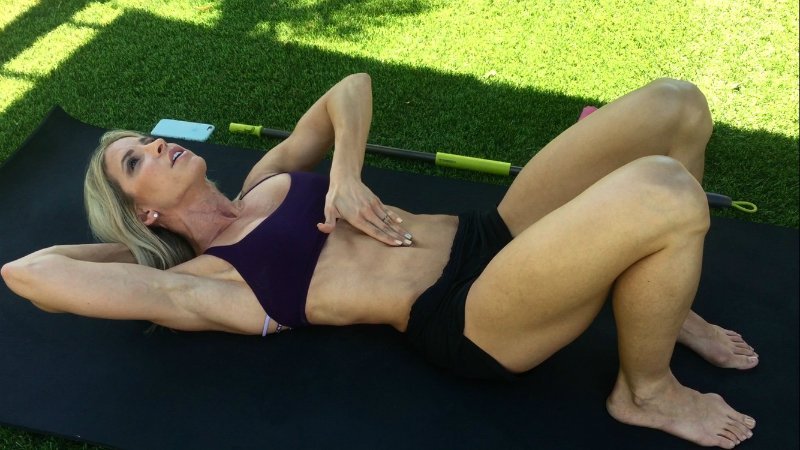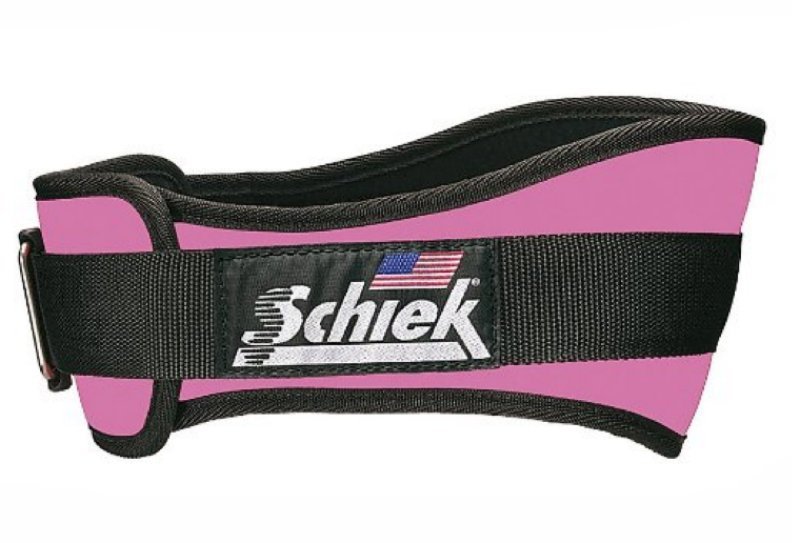Ok, here it is! Girl to girl, we need to discuss something I THINK is more common than I’ve ever believed! I’m getting a little personal and a little science-y on you today to talk about diastasis recti. Diastasis rect-who? Rect-ME! (Ok, stop).
I’m going to warn you up front. There is SO much to cover in this post—it’s a little long. If you wanna’ get straight to the meat (or the exercises you can do to fix your diastasis recti), scroll down. If you wanna’ learn more and figure out if you have this condition, keep reading.
Let me get you up to speed. Diastasis recti generally happens during pregnancy when the two large parallel bands of abdominal muscles separate due to the expanding uterus. Some women’s ab muscles go back to normal after the baby is born, and some do not…mine never have, and chances are yours haven’t either—which is why you are here.
The good news is that the diastasis caused by pregnancy can be corrected with exercises and stretches designed to optimize deep core muscular function. So ladies, don’t worry—your body wants to function right, and it will. We just need to wake up the right core muscles and teach them what to do! But let’s not get ahead of ourselves. Saving that for later.
Now how this happens and why it is worse for some women, no one is 100% sure. But we can hypothesize. It’s been said to be hereditary, but it may also be caused by working out your abs too soon after a baby is born, or even doing the wrong exercises WHILE pregnant. While I didn’t workout during ALL of my pregnancies (just the last 2), I personally feel like working my abs hard during prego worsened my condition. But that’s just my opinion.
Crazy fact, I didn’t even notice my ab separation until after Cash was born!! Yes, 3 kids later. I mean, I knew it was there, but I didn’t realize it was a medical condition. Embarrassingly enough, I always just thought I had definition down the center of my abs! Ha! Nope…wishful thinking. Just diastasis. Once I realized this odd look my midsection had wasn’t normal, nor was it normal for me to be able to literally stick my hand inside of my abs and touch my insides with just skin separating, I knew I had to do something about it. If you’d like a visual, just check out the pic below. This was posted on social media a couple of weeks back, and I got an overwhelming response from women (you!) that suffer from the same condition…
From a medical standpoint, until recently, I had a little over a 3-finger sized gap between my abs that was physically unprotected. Like I said, intestines…right below my skin. And during certain ab exercises, my insides would actually protrude through my abs, forming a weird point. Disgusting, I know. And it’s even scarier to think how vulnerable my vital organs were. If this went untreated, I could suffer from a major intestinal hernia, and given my level of activity (and types of heavy lifting), chances of this happening are higher than most. I mean, I already have an obvious umbilical hernia (my dramatic outtie belly button) so I figure I am more prone than most…
Extensive research on the topic taught me a few things…one of them being there are a handful of factors that make a woman more susceptible to diastasis recti:
- Having more than one child/pregnancy
- Having pregnancies close together
- Being?over the age of 35
- Having big babies
- Having multiple births
I know…some of you are looking at this ist realizing you’ve been double—or even quadruple—whammied! (I?m raising my hand to a couple). Don?t beat yourself up about what you cannot change because diastasis recti is very common—about 67% of all postpartum women have it. So you (and I) are in good company.
If you’re not sure if you are among the lucky few who steered clear of this pregnancy consequence, here’s an easy way to check:
- Lie on your back with your knees bent, soles of your feet close to your booty.
- Place one hand behind your neck and the other hand on your abdomen with your fingertips flat at your belly button, fingers facing downward.
- Gently push your fingertips into your abdomen while rolling your upper body off of the floor, chin towards the ceiling.
- Feel for a separation between those two ab muscles. Experts say that a 2-2.5 finger or more spread signals diastasis recti.
Now, let’s talk about our options moving forward. We can go the immediate and potentially easy (but expensive) route with surgery. BUT, surgery is not always recommended if you are still in your childbearing years…I mean think about it, one more baby, and you’ll pop those abs right back apart! As well, there is no guarantee that surgery will be 100% effective. (SIDE NOTE…Research on this topic started once Chris told me NO to this option because he wants more babies! Another topic for another day…but…).
So for me, at-home exercises and remedies are the way to go. Anytime I can avoid going under the knife, I will. And worst case? If the exercises don’t work, surgery as an option is always going to be there.
Before we go farther—a very important disclaimer: The following “fixes” are all based on my experience and my research, so please check with your doc BEFORE doing anything for your diastasis recti since each case is different. Okay, here goes:
Over this past year, my training protocol has changed as I have transitioned from CrossFit-style workouts to body building. Along with the training change-up, I changed the way I worked my abs too, focusing on decreasing (actually eliminating) the typical ab exercises and increasing the deep-core muscle exercises. I am happy to report that over this year, my abdominal muscle separation has decreased dramatically to less than 2 fingers!! But it still isn’t quite where I need it to be to consider myself healed.
The proof is in the pudding for me: A lot of this boils down to doing the RIGHT exercises. I realize that for so long I was doing what I intuitively thought would work (swing ups, sit ups, V ups, knees to bar, etc), but in reality, these move were working against me by ONLY working my Rectus Abdominus. The REAL muscles that needed working are known as the Transversus Abdominus and Lumbar Multifidus. These are the the most neglected of the ab muscles, but also happen to be arguably the most important. They lie beneath the Rectus Abdominus, supporting posture, controlling breathing during heavy lifts, and supporting the back. These are the muscles elite athletes work to add explosive power to training and are also the muscles we mamas need to work to relieve back pain, create a tighter midsection, AND improve our diastasis recti.
Some at-home exercises you can do to focus on these important muscles are below. I’ve also recorded a demonstration video for you (at the bottom of the post) so you can SEE how to perform these moves right and hear my instructions. Make sure that when you do these moves, you focus and move slowly—keeping the mind body connection. In other words, don’t just go through the moves. You’ll notice that breathing is a KEY component to all of these movements: Deep inhales, and exhale when you activate the muscles.
-
- Drawing In Exercise: Now technically every single move listed below requires you to “draw in,” so I figured I would do a little explaining. Drawing in is NOT sucking in (which uses the outer muscles). Drawing in is done by allowing those inner muscles to pull your abdomen deep inside toward your spine. Draw in from the lower region of your abs. Drawing in is something you can do in sets for as long as you can hold (work up to 60 seconds at a time), or it’s something you can simply do as you walk around your house. Believe it or not, your posture will improve big time with this! This can be done standing, sitting, lying down…you name it. Just DRAW IN!
- Vacuuming: No…not vacuuming your carpet (although I guess technically you can vacuum ON your carpet). I’m talking about the core exercise known by this name. I know I’ve talked about this before, but I’m going to talk about it again. Easily explained, simply stand up straight, inhale deeply, followed by an exhale. Once all of the air is deflated from your lungs, draw your belly button in and up toward your spine. HOLD (as tough as it is) for as long as you can. I aim for 30 seconds, but if holding your breath that long isn’t doable, simply keep the clock running and keep your belly button in and tight as you slowly breathe for the remainder of the 30 seconds. Try for 5-10 reps a day.
- Broomstick Rotations: With a dowel or a broomstick behind your neck, perform a vacuum, then when all air is exhaled and you are holding your breath with your abs squeezed, slowly rotate from side to side until you cannot hold your breath any longer. Breathe. Repeat 5-10 times.
- Abduction with Core Activation: Lie on your back with a resistance band around your knees. Exhale, engage your core and pelvic floor and pull your knees apart. Relax, inhale, and repeat for 10 reps. Be sure to keep your spine neutral and don’t press your lower back into the ground.
- Heel Slide: Lie on your back with both knees bent, feet flat. Exhale as you engage your core and pelvic floor, and slide one heel slowly along the ground until your leg is straight. Inhale and relax, then engage your core, exhale, and draw that heel back. Do 5 reps on each leg.
Once again, scroll to the bottom for my step-by-step video.
Now when it comes to traditional training and weight lifting, consider wearing a weight belt. It has worked WONDERS for me. Not only will a weight belt support your core while lifting heavy loads, but more importantly, it will act as a cue/reminder to activate and draw in with your core while lifting. Otherwise, we are naturally prone to distending our bellies during heavy lifting, only worsening our diastasis recti. This is the one I use…
So ladies, however you choose to take care of your diastasis recti, whether DIY exercises or surgery, know you are making the choice that is right for you! It’s a medical condition and not just a vain aesthetic concern, so if surgery is what you choose, then surgery it is! But if exercises are your method of healing, please keep me up to speed on your progress.
And in the meantime, have those babies, LOVE those babies, and appreciate every consequence of having such perfect little miracles! #BattleWounds
And finally…the demonstration vid…;)
Xoxo,
Heidi
Related reading:
Ask Heidi Anything: Carb Cycling While Prego?
My 1st Post Ruby Workout
My Pregnancy Workout: The Nasty 9s
My 5 Gym (and Home Gym) Must-Haves






262 Responses
Hi I have diastasis recti up to three fingers, i was just pulled out from my regular abs workout and now I?m kind of lost as I don?t want to loose what I?ve built, my last baby is 22 months now. I was wondering if you can hep me with a routine DR friendly or is just a matter of doing the exercises always with the draw-in?
Hi Maria: Before doing anything to help close that gap, please consult with your healthcare team about your DR and then follow their recommendations as to which exercises are best for you. If they give these exercises the okay, then go for it! 🙂
Hi! I am 6 months postpartum and have completed a different DR healing program – before I knew you had one! I just measured and I have a 1.5 finger gap- I started with a 3 finger gap. Is this still considered DR? Is it safe to do regular workouts such as sit ups and planks? I’m really wanting to do the Transform App and am trying it for a month but already on the first day I saw sit ups which I’ve learned can make the problem worse if not healed yet. Please help!
Hi Ruth: I’d definitely ask your healthcare team if you have any concerns/questions about your DR since the correct treatment can be different for each person. Also, in the app, you can choose a modified/alternate movement when necessary or skip a movement altogether if recommended by your healthcare team. And congratulations on getting that gap from 3 to 1.5!
Hi, I have just had my second child who is 4 months and my first child is 2. After both children I measured my gap which is a 1 finger gap. Before having both children I also had a 1 finger gap. Would you say this is natural as I have testing friends that haven?t had children and theirs is naturally 1 finger.
Thank you x
Hi Charlie: As far as we know, a 1 finger gap can be normal, but if you have any concerns, please discuss them with your healthcare team. And congratulations on the new baby! 🙂
I’m 15 years post partum. I have several medical conditions that limit my mobility but I know that the healthier I am the less I will hurt and the better I’ll feel in general. I’m 41 and honestly feeling ugly and disgusting. I’ve had to have several stomach surgeries since my last child because of my colon and one was a complete cut from the top of my stomach to my bikini line. I have had the kangaroo pouch since my last pregnancy- he was almost 10 lbs- and I knew that something wasn’t right with my stomach. A year ago I researched and found that this was my issue and that my colon surgery had made the condition worse.
With all this, would doing these exercises even work?
Hi Bonita: You’ve definitely been through a lot. I’d discuss these exercises with your healthcare team and then follow their recommendations. What is best for one woman might not be the best for another, and your doctor is the best one to help you decide what’s best for you. We wish you all the best! 🙂
Hi, I use the exercises here and also some other exercises and I am now at about 1 finger space. I just want to know if it’s possible to go to no space? Is there an end point to this?
Hi Jacintha: You’re doing amazing! I’d definitely talk to your healthcare team about this and follow their recommendations. 🙂
Hi heidi i have loose skin after pregnancy pls help.
Hi Ravinder: It can take some time for your skin to bounce back after pregnancy, so please be patient and hopefully you’ll see some improvement! And be sure you’re following a great nutrition program and working out regularly (both cardio and strength training). You got this! 🙂
Hi Heidi! Thank you for this information. I was wondering, is it possible to have diastasis recti without having a kid? I’m 29 and have always had a diamond body shape. It can be very frustrating and embarrassing when shopping for clothes. Even worse because I am 5’2. I also weigh below 130, but I have never had kids. I’m not quite sure what kind of doctor I should speak to about this issue. A specialist? I’m afraid of going to a plastic surgeon consultation because I feel like they will only want to sell me a “quick fix” rather than tell me the truth about correcting the issue. I doubt they would tell be it could be repaired through diet and exercise. I’m completely discouraged and very insecure so any information is helpful. I’ve read several articles online, but they are mainly directed toward mothers. I’m starting to think I did some abdominal damage and created separation from doing several sit up and crunches in middle school. Thanks in advance!
Hi Destiny: I would definitely talk to your ob/gyn about this, and it does make sense that you could have some ab separation without having given birth. We wish you all the best as you work to find out what’s going on! 🙂
Hello
I followed a routine on a youtube video for DR during 6 weeks .. however i have not seen a change… seems my DR just got worse… more noticeable which is very dissapointing …
How many times a week do you recommend doing these exercises(in your video)???
Hi Liliana: Heidi does these vacuum twists every day. If you haven’t already done so, I’d talk to your healthcare team about your DR and then follow their recommendations since each case and the treatment for each case can be different for each women. We wish you all the best! 🙂
Hello dear. It seems that i have DR about 3 fingers. My question is I would like to do these exercises but I also willing to do full body workout. What kind of workouts can I do beside to DR workouts? because you mentioned that some exercises will act negatively to the DR if we did them.
Hi Aliya: With any case of DR, we recommend you work with your healthcare team about any workout program and exercises, including those in this post. Since each case of DR, and the treatment for each case, can be a bit different, it is best to chat with your team and go from there.
I just wanted to thank you. I started doing these exercises in late February after having my second baby June 5th of 2018, and FINALLY my DR is closing. I have tried numberous programs in the past, including Mutu and many others, and it just wasn?t fixing it. After doing these exercises daily I have seen SO MUCH improvement. I am so grateful I found your site. THANK YOU!!
Hey Heidi, Thanks for the info. I was wondering if I can use an abdominal belt instead of the weight belt that you?ve shown. The one I have is like a corset which I was given when I was in the hospital after my c sec delivery 8 months back to help with the pain in my stitches during movement. And if yes should I be performing the exercises you?ve shown wearing this belt? Also does it help if I wear this belt during the day even when I?m not exercising? Kindly answer, it will help me with my fitness goals a lot. Thank you and God bless you!!
Hi Shikha!
I am not a healthcare professional. However, I am a mother of two and gave birth at home with a traditional midwife. With postpartum, we had to bind (wrap cloth/ wear corset) our belly for at least 40 days post birth. This helps to bring the Rectus Abdominus together to heal Diastasis recti and prevent hernia.
Again I am not a healthcare provider, but I would recommend you wear your corset as soon as you wake in the morning until you are ready for bed. Obviously not to wear in the shower or while you sleep.
I would also suggest you watch YouTube videos about the pelvic floor muscles and exercises. Which is to say kegle( spelling?) exercises.
I hope you find this helpful!
These exercises are helpful! What about ab coning with no DR? Will these exercises help with that?
Hi Britt: With any type of ab coning, we recommend you discuss the issue with your healthcare team and then go from there. You could show them these exercises and see if they think they would help! 🙂
Amazing advice, thank you gorgeous.
Is a 1 finger gap (1cm) still considered to be DR?
Thank you.
Hi Bek: Based on what we know, if you can fit 2 fingers into the gap between your ab muscles when contracted, then you have diastasis recti. If you have any concerns about whether or not you have DR, I’d chat with your healthcare team and then go from there. 🙂